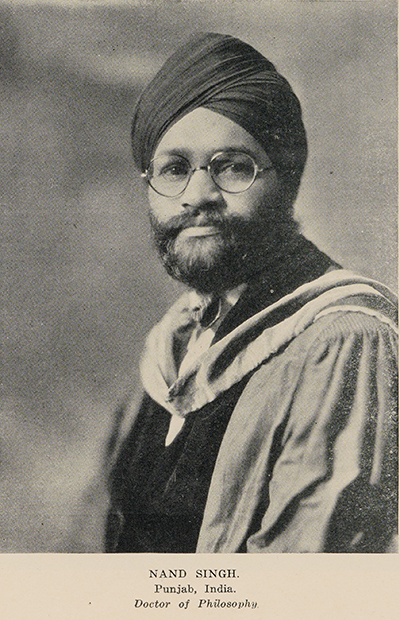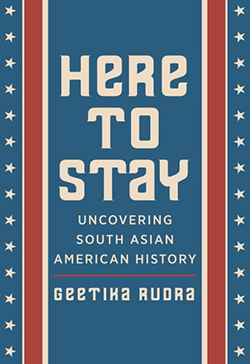Nand Singh, Milwaukee's First Recorded South Asian
 In recognition of Asian and Pacific American Heritage Month we took a look at Milwaukee Public Library's historic files to learn more about Nand Singh, Milwaukee's first recorded South Asian.
In recognition of Asian and Pacific American Heritage Month we took a look at Milwaukee Public Library's historic files to learn more about Nand Singh, Milwaukee's first recorded South Asian.
The 1920 Census listed more than 2,000 Hindus in the United States. Hindu (sometimes spelled Hindoo then) was the then-racial category used for people from the British colony of India (present-day India, Pakistan and Bangladesh), regardless if they were Hindu, Sikh, or Muslim. Sikhs are 2% of India’s population but accounted for more than 70% of South Asians arriving in America from the 1890s until Congress passed the Asiatic Barred Zone in 1917.
Nand Singh, a Sikh who spoke Punjabi as his first language, settled in Milwaukee. He was born as Nand Singh Sihra in Phillaur, Punjab, India on May 23, 1886 but usually used Nand Singh.
On May 26, 1912 The San Francisco Call reported he was one of six college-educated men from "Indostan" to receive a scholarship for further education at the University of California, Berkeley. He studied mechanical engineering for a year.
He wanted India to regain independence from Britain. He was part of Indian delegations that met with Colonial Under-Secretary John Anderson in London, Punjab Lt. Governor Michael O'Dwyer in Lahore and Viceroy of India, Charles Hardinage in Delhi.
Singh came to Milwaukee in 1916 to work at International Harvester at 14th Ave. and Park St. (1929-1930 street name changes, S. 19th St. and W. Bruce St.). He made his first appearance in the City Directory in 1918. He lived at 804 National Ave. (1930 address conversion: 1814 W. National Ave.), two blocks from the factory, and his occupation was listed as mechanical.

In 1919, he enrolled at Marquette University to study economics. He became a chemistry instructor in 1920 and received his Master of Commercial Science (MCS) degree in 1921. He was promoted to assistant professor and professor, and taught commerce and transportation, business administration and political science classes. He received his PhD in 1924.

Singh stood out with his turban in Roaring Twenties Milwaukee. He was a member of the civic organization City Club, Wisconsin Archeological Society, Milwaukee Engineering Society, and American Society of Mechanical Engineers. Newspapers mislabeled him a Hindu, described him as well-educated, mentioned and sometimes covered his lectures on India and other topics, including a couple of lectures at the Milwaukee Public Museum in the Library-Museum Building (Central Library).

He spoke highly of the United States and said home rule under the British flag would be a step towards independence and further trade with America. He wrote an op-ed column about prejudice and immigration in The Milwaukee Journal after Congress passed the Immigration Act of 1924.
The Naturalization Act of 1790 restricted citizenship to only white immigrants. South Asians applied for and started receiving citizenship in 1909 on the basis of being Indo-European. Different federal district and appellate courts ruled for or against naturalization. Bhagat Singh Thind, a Sikh World War I US Army veteran became a citizen in 1920. In 1923, the US Supreme Court ruled in United States v. Bhagat Singh Thind that South Asians were not white as understood by the "common man" despite most ethnographers classifying northern Indians as Caucasian (white) at the time. About 50 South Asian Americans were stripped of citizenship, leading to their loss of property and businesses.
Singh left Milwaukee in 1925 to become a Ford agent in India. Before boarding the RMS Alaunia in New York for Liverpool on November 28, 1925, he was interviewed for a wire service article published in dozens of newspapers. Reflecting attitudes of the time, it reported the "Hindoo" professor was leaving America without an American wife because of his beard.
He later started a carpentry school and worked on social causes in his village. Possibly the last American mention of Singh was A. L. Banks reminiscing about his friend in the Stockton Independent in 1935 and an invitation to visit him in Punjab.
 The Luce-Cellar Act of 1946 lifted the ban on South Asians to become citizens and the Immigration Act of 1952 removed the naturalization ban from all nonwhites. About 20,000 South Asians are currently living in the Milwaukee area. Geetika Rudra takes a personal journey discovering the lesser-known pre-1965 Hart-Cellar Immigration and Nationality Act years in Here to Stay: Uncovering South Asian American History.
The Luce-Cellar Act of 1946 lifted the ban on South Asians to become citizens and the Immigration Act of 1952 removed the naturalization ban from all nonwhites. About 20,000 South Asians are currently living in the Milwaukee area. Geetika Rudra takes a personal journey discovering the lesser-known pre-1965 Hart-Cellar Immigration and Nationality Act years in Here to Stay: Uncovering South Asian American History.
Add a selection from the library's Asian & Pacific Islanders booklist to your reading list for May, and read the MPL blogs on Vincent Lung and Peter Park, Milwaukee Asian American city planners, and George Yep, Milwaukee's first Chinese-American lawyer.
Image Credits:
The Hilltop
The Milwaukee Journal, February 12, 1922
